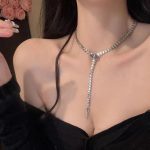Introduction
Mastering the art of wearing a tie clip can elevate your formal attire from good to great. Whether you are preparing for a job interview, a wedding, or even a Valentine’s Day dinner, knowing how to wear a tie clip is crucial. This guide will provide you with all the necessary information, including the correct placement, choosing the right style, and understanding the etiquette surrounding this accessory.

Understanding the Basics of a Tie Clip
Before diving into the specifics of how to wear a tie clip, it’s important to understand what a tie clip is and its purpose. A tie clip, also known as a tie bar, is a small metal or decorative piece that holds your tie in place, preventing it from flapping around. It serves both a functional and aesthetic role, adding a touch of elegance to your outfit. The key to using a tie clip effectively lies in its proper placement and the choice of style.
How to Choose the Right Tie Clip
Choosing the right tie clip involves considering several factors, such as the width of your tie, the material, and the design. Ideally, the tie clip should be about 75% the width of your tie. For example, if your tie is 3 inches wide, the tie clip should be around 2.25 inches. Additionally, the material and design should complement your overall outfit. For a classic look, opt for a simple metal clip, while for a more modern and trendy appearance, consider one with a unique design or pattern.
Correct Placement of a Tie Clip
The placement of a tie clip is critical to achieving a polished look. The general rule is to position the tie clip between the third and fourth buttons of your shirt. This ensures that the tie clip is neither too high nor too low. When fastening the clip, make sure it is secure but not too tight, as this can cause your tie to bunch up. The goal is to have a smooth, flat appearance that enhances your overall outfit.

Different Styles of Tie Clips
Tie clips come in a variety of styles, each suitable for different occasions and personal preferences. Classic styles include plain metal clips, often made of silver or gold, which are versatile and timeless. For a more personalized touch, you can choose tie clips with engravings, initials, or even small designs. Modern styles may feature geometric patterns, colorful accents, or even gemstones. The key is to select a style that complements your outfit and the occasion.
Tie Clip Etiquette
Understanding the etiquette of wearing a tie clip is just as important as knowing how to wear it. Proper etiquette ensures that your tie clip enhances your overall appearance and conveys a sense of style and professionalism. Here are some key points to keep in mind:
Avoid Using with Button-Down Collar Shirts:
Redundancy: One common mistake is to use a tie clip with a button-down collar shirt. The buttons on the collar already serve the purpose of keeping the tie in place, making the tie clip redundant.
Aesthetic Considerations: Adding a tie clip to a button-down collar can create a cluttered and overly formal look. The buttons provide enough structure and stability, so an additional accessory is not necessary.
Do Not Use with Bow Ties:
Inappropriate Look: Avoid using a tie clip with a bow tie. A bow tie is designed to sit neatly around the neck and does not require a clip to keep it in place.
Visual Mismatch: A tie clip can look out of place and awkward when paired with a bow tie. Disrupting the elegant and balanced appearance of the bow tie.

Proper Alignment:
Horizontal Positioning: Ensure that the tie clip is aligned horizontally. This means it should be placed straight across the tie, parallel to the ground. A crooked or tilted tie clip can look sloppy and unprofessional.
Centered Placement: The tie clip should be centered between the two buttons of your shirt. Typically, between the third and fourth buttons. This creates a symmetrical and balanced look.
Avoid Covering the Shirt Pocket:
Clear Visibility: Make sure the tie clip does not cover any part of the shirt pocket. If you have a pocket square, the tie clip should be positioned above it. Ensuring both accessories are visible and do not overlap.
Functional and Aesthetic Balance: Placing the tie clip above the pocket keeps it functional and visually appealing. It should complement, not obscure, other elements of your outfit.
Coordinate with Other Accessories:
Matching Metals: If you are wearing other metal accessories such as cufflinks, a belt buckle, or a watch, ensure that the metals match. For example, if your cufflinks are silver, your tie clip should also be silver.
Consistent Style: Choose a tie clip that complements the style and formality of your outfit. A more ornate or decorative tie clip may be appropriate for a formal event, while a simpler, minimalist design is better for everyday wear.
Proper Fit:
Secure but Not Too Tight: The tie clip should hold the tie securely to the shirt without causing any damage. It should not be too tight, as this can leave marks on the fabric or cause the tie to bunch up.
Comfortable Wear: Ensure that the tie clip is comfortable and does not dig into your chest. It should be snug enough to keep the tie in place but not so tight that it causes discomfort.
By following these etiquette guidelines, you can ensure that your tie clip enhances your overall appearance and adds a touch of sophistication to your outfit. These small details can make a big difference in how you present yourself, whether in a professional setting or at a formal event.
Pairing a Tie Clip with Other Accessories
A well-coordinated outfit includes the right combination of accessories. When wearing a tie clip, consider pairing it with other complementary items such as cufflinks, a watch, or a pocket square. Ensure that these accessories match in terms of color and style. For example, if you have a silver tie clip, matching it with silver cufflinks and a watch can create a cohesive and stylish look. On Valentine’s Day, you might want to add a touch of red or pink to your accessories to match the theme.

Maintaining Your Tie Clip
To ensure your tie clip remains in top condition and continues to be a stylish and valuable addition to your wardrobe, regular maintenance is essential. Here are some detailed steps to help you care for your tie clip:
Regular Cleaning:
Dust and Tarnish Removal: Periodically clean your tie clip with a soft, lint-free cloth to remove any dust, dirt, or tarnish. This simple step can help maintain its shine and appearance.
Frequency: Aim to clean your tie clip at least once a month, or more frequently if you wear it often. This will prevent the buildup of grime and keep it looking its best.
Cleaning Metal Clips:
Mild Soap and Water Solution: If your tie clip is made of metal, you can use a mild soap and water solution for a deeper clean. Mix a small amount of gentle dish soap with warm water.
Gentle Scrubbing: Dip a soft, non-abrasive cloth into the soapy water and gently rub the tie clip. Pay special attention to any crevices or detailed areas where dirt may accumulate.
Rinsing and Drying: Rinse the tie clip thoroughly with clean water to remove all soap residue. Use a soft, dry cloth to pat it dry, ensuring no moisture remains. Allow it to air dry completely before storing.
Storing Your Tie Clip:
Jewelry Box or Pouch: Store your tie clip in a jewelry box or a small, soft pouch to protect it from scratches and damage. This will also help prevent it from coming into contact with other items that might cause dents or scratches.
Separate Compartments: If you have multiple tie clips, consider using separate compartments or individual pouches to avoid them rubbing against each other.
Avoid Humid Environments: Store your tie clip in a cool, dry place away from direct sunlight and humidity. Excessive moisture can lead to tarnishing, especially for metal clips.
Handling with Care:
Gentle Handling: Always handle your tie clip with care. Avoid dropping it or subjecting it to rough handling, as this can cause dents, scratches, or other damage.
Avoid Chemicals: Keep your tie clip away from harsh chemicals, such as perfumes, lotions, and hairsprays. These can cause discoloration and damage to the finish.
Professional Maintenance:
Periodic Professional Cleaning: Consider taking your tie clip to a professional jeweler for periodic cleaning and inspection. They can provide a more thorough cleaning and check for any signs of wear or damage that may need repair.
Repairs and Polishing: If your tie clip shows signs of wear, such as loose parts or a dull finish, a professional can polish and repair it, restoring its original luster.

By following these maintenance tips, you can ensure that your tie clip remains a valuable and stylish accessory for years to come. Proper care not only enhances its longevity but also ensures that it continues to complement your outfits and add a touch of sophistication to your overall appearance.
Conclusion
Knowing how to wear a tie clip is an essential skill for anyone who wants to look sharp and put-together. By following the tips provided in this guide, you can master the art of tie clip placement, style selection, and etiquette. Whether you are dressing up for a special occasion like Valentine’s Day or simply want to enhance your everyday formal wear, a well-placed tie clip can make all the difference. Remember, the key is to choose the right style, place it correctly, and pair it with other accessories to create a harmonious and stylish look.

